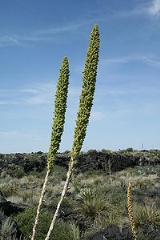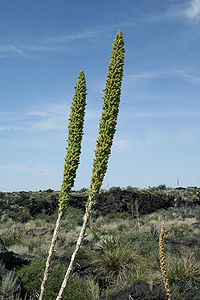
Sotol
Encyclopedia
Sotol is a distilled spirit made from the Dasylirion wheeleri
(commonly known as Desert Spoon or, in Spanish, sotol), a plant that grows in the wilds of Northern Mexico
, New Mexico
, West Texas
, and the Texas Hill Country
. It is known as the state drink of Chihuahua, Durango and Coahuila. There are few commercial examples available. It is produced in a manner similar to the more common artisanal mezcal
s of central Mexico.
. These artifacts date to around 7000 BCE.
The base of a cooked sotol stem may be eaten rather like an artichoke leaf (by scraping across the front teeth). This remnant, called a "quid", resembles a spoon and can be used as one. Archaeological sites where "Desert Spoon" was eaten in this way are full of discarded quids thousands of years old.
Sotol and lechuguilla flower-stalks used as atlatl dart hindshafts were found in Ceremonial Cave (Hueco Mountains, near El Paso, Texas). Sotol may also have been affiliated with fire because the sotol stem was used as a fireplow.
A humanoid figure with a spray of spiky leaves for a head and a black stripe down the middle of its body may represent the magical spirit of sotol. Sometimes it appears in connection with hunting scenes. Sometimes it appears surrounded by orange ochre flames and black smoke.
The presence, at these rock shelters, of troughs a half meter long and four centimeters deep and mounds of quids suggest production of spirits using sotol as far back as 9000 years ago. The Fate Bell Shelter murals may, in part, be a tribute to the remarkable usefulness of sotol.
grassland between 3,000 and 6,500 feet above sea level. Unlike the Agave
, which flower only once in their lifetime, Sotols produce a flower stalk every few years. Once the plant matures, it is harvested similar to Agave plants when making Mezcal or Tequila. The outer leaves are removed to reveal the center core, which is taken back to the distillery. The core can then be cooked and/or steamed, shredded, fermented, and distilled.

Dasylirion wheeleri
Dasylirion wheeleri is a flowering plant native to arid environments of northern Mexico, in Chihuahua and Sonora and in the southwestern United States, in the Sonoran Desert in Arizona, and also in New Mexico and Texas.-Description:Dasylirion wheeleri is a moderate to slow-growing evergreen shrub...
(commonly known as Desert Spoon or, in Spanish, sotol), a plant that grows in the wilds of Northern Mexico
Mexico
The United Mexican States , commonly known as Mexico , is a federal constitutional republic in North America. It is bordered on the north by the United States; on the south and west by the Pacific Ocean; on the southeast by Guatemala, Belize, and the Caribbean Sea; and on the east by the Gulf of...
, New Mexico
New Mexico
New Mexico is a state located in the southwest and western regions of the United States. New Mexico is also usually considered one of the Mountain States. With a population density of 16 per square mile, New Mexico is the sixth-most sparsely inhabited U.S...
, West Texas
Texas
Texas is the second largest U.S. state by both area and population, and the largest state by area in the contiguous United States.The name, based on the Caddo word "Tejas" meaning "friends" or "allies", was applied by the Spanish to the Caddo themselves and to the region of their settlement in...
, and the Texas Hill Country
Texas Hill Country
The Texas Hill Country is a vernacular term applied to a region of Central Texas featuring tall rugged hills consisting of thin layers of soil atop limestone or granite. It also includes the Llano Uplift and the second largest granite monadnock in the United States, Enchanted Rock, which is located...
. It is known as the state drink of Chihuahua, Durango and Coahuila. There are few commercial examples available. It is produced in a manner similar to the more common artisanal mezcal
Mezcal
Mezcal, or mescal, is a distilled alcoholic beverage made from the maguey plant native to Mexico. The word mezcal comes from Nahuatl metl and ixcalli which mean 'oven cooked agave.'...
s of central Mexico.
Early history
At the Fate Bell Shelter, which is on the U.S. side of the Rio Grande, sotol is depicted in paintings on the rock walls. Sandals, baskets, ropes, mats, and many other items of sotol fiber show it was a highly important resource to Ancient Pueblo People of the Basketmaker cultureBasketmaker (culture)
The Basketmaker culture of the Ancient Pueblo People began about 1500 BC and continued until about AD 500 with the beginning of the Pueblo I Era...
. These artifacts date to around 7000 BCE.
The base of a cooked sotol stem may be eaten rather like an artichoke leaf (by scraping across the front teeth). This remnant, called a "quid", resembles a spoon and can be used as one. Archaeological sites where "Desert Spoon" was eaten in this way are full of discarded quids thousands of years old.
Sotol and lechuguilla flower-stalks used as atlatl dart hindshafts were found in Ceremonial Cave (Hueco Mountains, near El Paso, Texas). Sotol may also have been affiliated with fire because the sotol stem was used as a fireplow.
A humanoid figure with a spray of spiky leaves for a head and a black stripe down the middle of its body may represent the magical spirit of sotol. Sometimes it appears in connection with hunting scenes. Sometimes it appears surrounded by orange ochre flames and black smoke.
The presence, at these rock shelters, of troughs a half meter long and four centimeters deep and mounds of quids suggest production of spirits using sotol as far back as 9000 years ago. The Fate Bell Shelter murals may, in part, be a tribute to the remarkable usefulness of sotol.
History
Local Chihuahua Indians fermented sotol juice into a beer-like alcoholic beverage as early as 800 years ago. In the 16th century, Spanish colonists introduced European distillation techniques to produce a spirit. Sotol is now beginning to achieve international recognition like its cousins, mezcal and tequila.Production
The Desert Spoon takes approximately 15 years to mature, and creates only one bottle of Sotol per plant. It typically grows on rocky slopes in the Chihuahuan desertChihuahuan Desert
The Chihuahuan Desert is a desert, and an ecoregion designation, that straddles the U.S.-Mexico border in the central and northern portions of the Mexican Plateau, bordered on the west by the extensive Sierra Madre Occidental range, and overlaying northern portions of the east range, the Sierra...
grassland between 3,000 and 6,500 feet above sea level. Unlike the Agave
Agave
Agave is a genus of monocots. The plants are perennial, but each rosette flowers once and then dies ; they are commonly known as the century plant....
, which flower only once in their lifetime, Sotols produce a flower stalk every few years. Once the plant matures, it is harvested similar to Agave plants when making Mezcal or Tequila. The outer leaves are removed to reveal the center core, which is taken back to the distillery. The core can then be cooked and/or steamed, shredded, fermented, and distilled.

Types
Age classifications:- Plata – Un-aged, straight from distillation to the bottle.
- Reposado (rested) – Aged several months to a year.
- Añejo – Aged for at least one year
External links
- Sotol Moonshine is a short story about the drink by terryfunk.
- Reviews of several commercially produced brands of Sotol.

